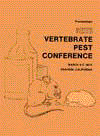Vertebrate Pest Conference: Proceedings

Vertebrate Pest Conference Proceedings: 6th (1974)
Date of this Version
March 1974
Document Type
Article
Abstract
The palatability of rodenticide baits has recently been the subject of renewed interest in industry and regulatory agencies. The requirement that a bait, especially those with anticoagulant rodenticides, be consumed by the target species is a fundamental requirement for effectiveness. This has been overlooked at times, with the result that in some instances, rodenticides have been relatively ineffective due to a lack of acceptance. The measurement of palatability and rodent acceptance is a controversial area. The procedures used have been subjected to criticism, often uninformed criticism, and the projection of the experimental data to use conditions has also been debated. The regulatory agencies have utilized a concept in that the rodenticide bait is in effect challenged by an attractive non-toxicant food source. The rationale is that under use conditions an existing food source is present to sustain the rodent population before the introduction of the rodenticide bait. The rodenticide bait should therefore be capable of being consumed in significant quantities in the presence of the food source. The problems arise in the interpretation of the data and in its projection to use conditions. Specifically, if bait A, is accepted at 33 percent and bait B is accepted at a level of 29 percent, how significant is the difference? The experimental conditions have been relatively well standardized. Laboratory rats, at least 10 of each sex, are housed in individual cages. The rats are offered a highly palatable, easily consumed food source, and the candidate bait, over a period of 15 days. The acceptance of the candidate bait is computed as a percentage of the total food intake from all sources over the period of the test.

